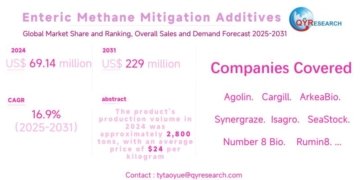The mobile edge computing (MEC) market is projected to grow at a remarkable CAGR of 49.7% from 2022 to 2032, with its value reaching US$ 58.4 billion by 2032, up from US$ 1 billion in 2022. This growth is driven by the increasing demand for low-latency processing, real-time decision-making, and enhanced Quality of Experience (QoE) across industries. The rise of 5G, autonomous vehicles, and IoT solutions offers significant opportunities, while challenges such as infrastructure limitations and the need for skilled labor may hinder expansion. Despite setbacks from the COVID-19 pandemic, the future of MEC looks promising, fueled by innovations in AR/VR and smart network technologies.
𝐑𝐞𝐪𝐮𝐞𝐬𝐭 𝐟𝐨𝐫 𝐒𝐚𝐦𝐩𝐥𝐞: https://www.persistencemarketresearch.com/samples/33067
𝐓𝐡𝐞 𝐑𝐢𝐬𝐞 𝐨𝐟 𝐌𝐨𝐛𝐢𝐥𝐞 𝐄𝐝𝐠𝐞 𝐂𝐨𝐦𝐩𝐮𝐭𝐢𝐧𝐠: 𝐑𝐞𝐯𝐨𝐥𝐮𝐭𝐢𝐨𝐧𝐢𝐳𝐢𝐧𝐠 𝐃𝐚𝐭𝐚 𝐏𝐫𝐨𝐜𝐞𝐬𝐬𝐢𝐧𝐠
Mobile Edge Computing refers to a distributed computing paradigm that brings data storage and processing closer to the user’s location, at the “edge” of the network. This reduces latency, conserves bandwidth, and enhances the overall user experience by enabling real-time data analysis. MEC technology leverages edge devices and localized data centers to process data near the source rather than relying solely on centralized cloud systems.
As industries across sectors demand faster, more efficient computing solutions, MEC has gained significant traction in mobile networks, the Internet of Things (IoT), autonomous vehicles, augmented reality (AR), and virtual reality (VR) applications. The MEC market’s rapid growth can be attributed to its ability to meet the increasing need for low-latency services in an interconnected world.
𝐊𝐞𝐲 𝐃𝐫𝐢𝐯𝐞𝐫𝐬 𝐨𝐟 𝐌𝐨𝐛𝐢𝐥𝐞 𝐄𝐝𝐠𝐞 𝐂𝐨𝐦𝐩𝐮𝐭𝐢𝐧𝐠 𝐌𝐚𝐫𝐤𝐞𝐭 𝐆𝐫𝐨𝐰𝐭𝐡
1. Increasing Data Traffic and Demand for Real-Time Processing
As mobile data traffic continues to rise exponentially, traditional cloud computing systems struggle to manage the volume and speed required to meet the needs of modern applications. MEC provides an ideal solution by enabling data to be processed closer to the source. This reduces congestion and enhances the speed and efficiency of services, making it especially valuable for applications requiring real-time processing, such as autonomous vehicles, remote monitoring, and smart cities.
2. Emergence of 5G Networks
The global rollout of 5G networks is a crucial factor in the growth of the MEC market. 5G offers faster data transmission speeds, lower latency, and higher capacity, which makes edge computing even more critical. MEC facilitates the utilization of 5G’s capabilities by ensuring that data is processed near its source, enabling near-instantaneous decision-making and seamless integration with 5G networks.
3. IoT Growth and Smart Device Integration
The Internet of Things (IoT) is a key driver of the MEC market. As more devices become interconnected, the need for efficient and quick data processing increases. MEC allows for the swift processing of data generated by IoT devices, ensuring that actionable insights can be derived quickly and with minimal latency. This is especially vital in industries such as manufacturing, healthcare, and agriculture, where real-time data can significantly improve operations and outcomes.
4. Need for Enhanced Security
With the increasing volume of data generated and transmitted by mobile devices and IoT systems, the need for robust security measures has never been greater. MEC provides improved security by processing data locally rather than sending it to centralized cloud servers. This decentralized model reduces the risk of data breaches and ensures that sensitive information is kept closer to its point of origin.
𝐀𝐩𝐩𝐥𝐢𝐜𝐚𝐭𝐢𝐨𝐧𝐬 𝐃𝐫𝐢𝐯𝐢𝐧𝐠 𝐌𝐨𝐛𝐢𝐥𝐞 𝐄𝐝𝐠𝐞 𝐂𝐨𝐦𝐩𝐮𝐭𝐢𝐧𝐠 𝐀𝐝𝐨𝐩𝐭𝐢𝐨𝐧
1. Autonomous Vehicles
One of the most promising applications of MEC is in autonomous vehicles. These vehicles rely on real-time data processing to navigate roads safely and efficiently. By integrating MEC into vehicle systems, data generated from sensors, cameras, and LiDAR devices can be processed locally, allowing for near-instantaneous decisions that are crucial for the safe operation of self-driving cars.
2. Smart Cities and Smart Infrastructure
MEC plays a pivotal role in the development of smart cities by supporting real-time analytics for urban planning, traffic management, and public safety. By processing data at the edge, MEC reduces the need for sending large volumes of data to centralized servers, allowing for faster responses to dynamic urban conditions. This is particularly useful in smart traffic systems, public safety applications, and environmental monitoring.
3. Healthcare and Remote Monitoring
The healthcare industry is increasingly adopting MEC to improve patient care through real-time monitoring and diagnostics. By processing data locally, healthcare professionals can access critical information more quickly and efficiently. MEC also supports telemedicine applications, enabling doctors to monitor patients remotely and make informed decisions without delays, enhancing the overall quality of care.
4. Augmented and Virtual Reality (AR/VR)
AR and VR applications require high levels of data processing and low latency to deliver immersive experiences. MEC helps deliver this by reducing the need for cloud-based processing, thus ensuring that data is processed in real-time. In gaming, education, and training applications, MEC enables a smoother and more engaging user experience.
5. Industrial Automation
The rise of Industry 4.0 has led to an increased demand for real-time data processing in manufacturing environments. MEC supports industrial automation by enabling machines, robots, and sensors to make immediate decisions without the need for cloud communication. This improves efficiency, reduces downtime, and enhances the productivity of manufacturing processes.
𝐑𝐞𝐠𝐢𝐨𝐧𝐚𝐥 𝐈𝐧𝐬𝐢𝐠𝐡𝐭𝐬: 𝐋𝐞𝐚𝐝𝐢𝐧𝐠 𝐏𝐥𝐚𝐲𝐞𝐫𝐬 𝐚𝐧𝐝 𝐌𝐚𝐫𝐤𝐞𝐭 𝐓𝐫𝐞𝐧𝐝𝐬
The global Mobile Edge Computing market is experiencing substantial growth across regions, with North America, Europe, and Asia-Pacific expected to lead the market in terms of revenue and adoption.
• North America: The North American market is driven by significant advancements in telecommunications infrastructure, particularly with the ongoing deployment of 5G networks. The U.S. and Canada are expected to remain key players in the MEC market, with major tech companies investing heavily in edge computing technology.
• Europe: Europe is another major market for MEC, driven by the increasing number of smart cities and IoT applications. The European Union’s focus on enhancing digital infrastructure and enabling advanced technology adoption will contribute to the growth of MEC in this region.
• Asia-Pacific: The Asia-Pacific region is experiencing rapid urbanization and industrialization, which are driving the demand for MEC solutions. Countries such as China, Japan, and India are focusing on enhancing their telecommunication infrastructure to support the adoption of 5G and edge computing.
𝐂𝐡𝐚𝐥𝐥𝐞𝐧𝐠𝐞𝐬 𝐢𝐧 𝐭𝐡𝐞 𝐌𝐨𝐛𝐢𝐥𝐞 𝐄𝐝𝐠𝐞 𝐂𝐨𝐦𝐩𝐮𝐭𝐢𝐧𝐠 𝐌𝐚𝐫𝐤𝐞𝐭
Despite its tremendous growth prospects, the Mobile Edge Computing market faces several challenges. One of the major obstacles is the complexity of managing distributed computing systems at scale. Ensuring seamless integration between edge devices, local servers, and cloud infrastructure can be difficult. Additionally, the cost of implementing MEC technology, particularly for small and medium-sized businesses, can be a barrier to adoption.
Another challenge is data privacy and security concerns. As MEC involves the decentralization of data processing, ensuring that sensitive information remains secure across multiple points of access is crucial. Companies must implement robust security measures to address these concerns and maintain customer trust.
𝐂𝐨𝐧𝐜𝐥𝐮𝐬𝐢𝐨𝐧: 𝐀 𝐏𝐫𝐨𝐦𝐢𝐬𝐢𝐧𝐠 𝐅𝐮𝐭𝐮𝐫𝐞 𝐟𝐨𝐫 𝐌𝐨𝐛𝐢𝐥𝐞 𝐄𝐝𝐠𝐞 𝐂𝐨𝐦𝐩𝐮𝐭𝐢𝐧𝐠
The Mobile Edge Computing market is set for significant growth, driven by the increasing demand for real-time data processing, the expansion of 5G networks, and the proliferation of IoT devices. As industries across the globe continue to embrace digital transformation, MEC will play a vital role in enhancing network efficiency, reducing latency, and enabling the next generation of mobile applications.
With a projected market size of US$ 58.4 billion by 2032 and a remarkable 49.7% CAGR, the MEC market offers immense opportunities for businesses and technology providers. As the demand for edge computing solutions continues to rise, the potential for innovation and expansion in this field is vast, making it one of the most exciting technology trends to watch in the coming decade.
𝐂𝐨𝐧𝐭𝐚𝐜𝐭 𝐔𝐬:
Persistence Market Research
G04 Golden Mile House, Clayponds Lane
Brentford, London, TW8 0GU UK
USA Phone: +1 646-878-6329
UK Phone: +44 203-837-5656
Email: sales@persistencemarketresearch.com
Web: https://www.persistencemarketresearch.com
𝐀𝐛𝐨𝐮𝐭 𝐏𝐞𝐫𝐬𝐢𝐬𝐭𝐞𝐧𝐜𝐞 𝐌𝐚𝐫𝐤𝐞𝐭 𝐑𝐞𝐬𝐞𝐚𝐫𝐜𝐡:
At Persistence Market Research, we specialize in creating research studies that serve as strategic tools for driving business growth. Established as a proprietary firm in 2012, we have evolved into a registered company in England and Wales in 2023 under the name Persistence Research & Consultancy Services Ltd. With a solid foundation, we have completed over 3600 custom and syndicate market research projects, and delivered more than 2700 projects for other leading market research companies’ clients.
Our approach combines traditional market research methods with modern tools to offer comprehensive research solutions. With a decade of experience, we pride ourselves on deriving actionable insights from data to help businesses stay ahead of the competition. Our client base spans multinational corporations, leading consulting firms, investment funds, and government departments. A significant portion of our sales comes from repeat clients, a testament to the value and trust we’ve built over the years.
This release was published on openPR.

















